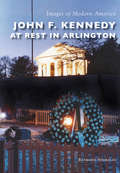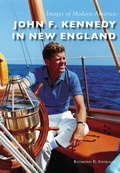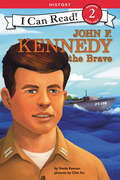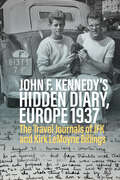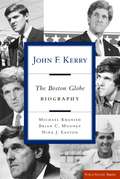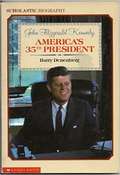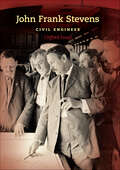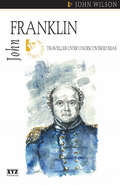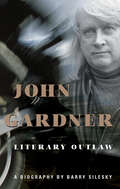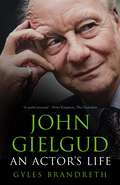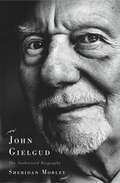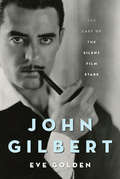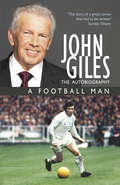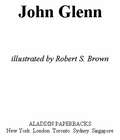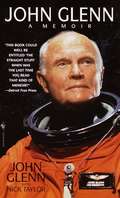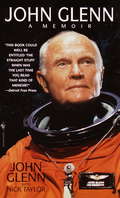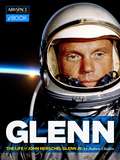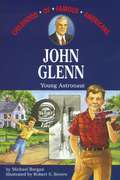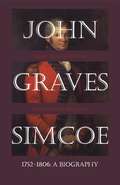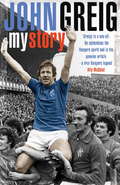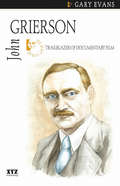- Table View
- List View
John F. Kennedy at Rest in Arlington (Images of Modern America)
by Raymond SinibaldiJohn F. Kennedy is one of only three presidents not interred in his home state. Sitting next to his coffin on the flight home from Dallas, Jacqueline Kennedy began formulating plans for his funeral and burial. The following day, in a raw November rain, she selected the Arlington hillside as his final resting place. For three days, in a majestic display of elegance, strength, grace, and courage, the 34-year-old widow led the nation through the excruciating task of laying its president to rest. Within days, she returned to Arlington, and in a brief ceremony, their two infant children were laid to rest beside their father, beneath the eternal flame she lit. Work immediately began on the permanent resting place and memorial, and in March 1967, the final reinterment took place. A half-century later, four million people come yearly to pay their respects to President Kennedy, his widow, and two children.
John F. Kennedy in New England (Images of Modern America)
by Raymond P. SinibaldiOn May 29, 1917, John F. Kennedy was born in the Kennedy home in Brookline, Massachusetts. As a toddler, he wandered the sands of Nantasket Beach in Hull. When he was a little boy, he swam in the Atlantic waters of Sandy Beach in Cohasset, and as a teenager, he learned to sail on Nantucket Sound off the Cape Cod hamlet of Hyannis Port. He was married on the lawn of the Auchincloss Estate in Newport on the shores of Rhode Island Sound, and as president, he sailed the waters off John’s Island in Maine, while the Navy’s Blue Angels flew over in a salute to their commander in chief. John Kennedy was marked and then defined by his time sailing the seas off New England’s shores, and as his brother Ted once said, it was Hyannis Port where he enjoyed his “happiest times.”
John F. Kennedy the Brave (I Can Read Level 2)
by Sheila KeenanThe life of President John F. Kennedy is explored in this early reader biography. “Ask not what your country can do for you—ask what you can do for your country.”When he was a young boy, John Fitzgerald Kennedy wondered about what happened in the world. He wanted to change the world when he grew up, and he did just that!Beginning readers will learn about the milestones in John F. Kennedy’s life in this Level Two I Can Read biography, which combines a traditional, illustrated narrative with historical photographs at the back of book. Complete with a timeline, photographs, and little-known facts about the United States’ thirty-fifth president, the brave John F. Kennedy.John F. Kennedy the Brave is a Level Two I Can Read, geared for kids who read on their own but still need a little help.
John F. Kennedy: 35th President Of The United States
by Lucille FalkofPresents the childhood, education, employment, and political career of the youngest man ever elected president of the United States.
John F. Kennedy’s Hidden Diary, Europe 1937: The Travel Journals of JFK and Kirk LeMoyne Billings
by Oliver LubrichPresenting the 1937 diaries of John F. Kennedy’s tour of Europe, this volume offers insights into his early experiences on a continent under the shadow of Nazism. In 1937, while still a student, John F. Kennedy undertook a grand tour of Europe with his close friend and traveling companion, Lem Billings. On this journey he began to keep a diary, which is reproduced here in full and provides an unadulterated account of his thoughts and feelings. Superficially, it presents a picture of two young men enjoying their summer, sightseeing, going to the movies, bars and night clubs; but behind this we find, in Kennedy’s political observations and encounters, the looming shadow of Nazism. In retrospect there are blind spots and misjudgments, but also insights of great topicality, for example on populism, and propaganda and its potent effects. On this trip and during his later travels in Germany, Kennedy engaged with the crucial questions of his later presidency: How does a dictatorship work? How is an alternative concept of society to be countered? And how can an impending war be averted? Kennedy’s European and Russian policies and also his famous Berlin speech of 1963 (“Ich bin ein Berliner”) are to be understood against this background. In addition to numerous archive photographs, this volume contains Kennedy’s complete diary of his 1937 trip to Europe and, as a counterpart, the “Scrapbook” of Lem Billings who documented it from his perspective.
John F. Kerry: The Boston Globe Biography
by Nina J. Easton Michael Kranish Brian MooneyJohn F. Kerry: The Boston Globe Biography tells the ambitious story of the former Presidential candidate and Senator, and current Secretary of State. Based on a highly regarded series published in The Boston Globe and augmented by years of additional reporting, it explores John Kerry's background, his service in the military, his early legal and political career, and his legislative record. Offering an incisive, frank look at the man who has spent decades in the highest levels of government, this biography is important reading for anyone interested in the life of the man now poised to be the face of his country overseas.
John Fitzgerald Kennedy: America's 35th President
by Barry DenenbergStraightforward account of the life and short presidency of John F. Kennedy.
John Frank Stevens: Civil Engineer (Railroads Past and Present)
by Clifford FoustOne of America's foremost civil engineers of the past 150 years, John Frank Stevens was a railway reconnaissance and location engineer whose reputation was made on the Canadian Pacific and Great Northern lines. Self-taught and driven by a bulldog tenacity of purpose, he was hired by Theodore Roosevelt as chief engineer of the Panama Canal, creating a technical achievement far ahead of its time. Stevens also served for more than five years as the head of the US Advisory Commission of Railway Experts to Russia and as a consultant who contributed to many engineering feats, including the control of the Mississippi River after the disastrous floods of 1927 and construction of the Boulder (Hoover) Dam. Drawing on Stevens's surviving personal papers and materials from projects with which he was associated, Clifford Foust offers an illuminating look into the life of an accomplished civil engineer.
John Franklin
by John WilsonJohn Franklin explored and charted Canada’s arctic seacoast in 1819-1822, 1825-27, and 1845. On the first expedition he nearly starved and on the third he died. None of his men survived the third expedition, but the search for clues to their fate helped open up the North and his celebrated Canadian song and stories.
John Gardner: Literary Outlaw
by Barry SileskyFor a decade--from 1973 to 1982--John Gardner was one of America's most famous writers and certainly its most flamboyantly opinionated. His 1973 novel, The Sunlight Dialogues, was on the New York Times bestseller list for fourteen weeks. Once in the limelight, he picked public fights with his peers, John Barth, Joseph Heller, and Norman Mailer among them, and wrote five more bestsellers. Gardner's personal life was as chaotic as his writing life was prolific. At twenty, he married his cousin Joan, and after a long marriage that was both passionate and violent, left her for Liz Rosenberg, a student. Only a few years later, he left Rosenberg for another student, Susan Thornton. Famous for disregarding his own safety, he rode his motorcycle at crazy speeds, incurred countless concussions, and once broke both of his arms. He survived what was diagnosed as terminal colon cancer only to resume his prodigious drinking and to die in a motorcycle accident at age forty-nine, a week before his third wedding. Biographer Barry Silesky captures John Gardner's fabulously contradictory genius and his capacity to both dazzle and infuriate. He portrays Gardner as a man of unrestrained energy and blatant contempt for convention and also as a man whose charisma drew students and devoted followers wherever he went. Amazingly, Gardner published twenty-nine books in all, including eleven fiction titles, a book-length epic poem, six books of medieval criticism, and a major biography. Twenty-one years after his death, his On Moral Fiction and The Art Of Fiction are still read and debated in MFA programs across the country. This is a full-scale biography of a writer who was, for ten years, almost bigger than life. It lives up to its subject magnificently.
John Gielgud: An Actor's Life
by Gyles Brandreth‘A sense of delight permeates Gyles Brandreth’s John Gielgud: An Actor’s Life … Brandreth combines neat reportage, deft evocation and lovely tales about a man he knew and relished.’ – The Times‘A delightful memoir which tells you all you need to know and collects all the anecdotes.’ – Daily MailJohn Gielgud was born in April 1904. When he died in May 2000, he was honoured as ‘the giant of twentieth-century theatre’. In this updated, acclaimed biography, Gyles Brandreth draws from over thirty years of conversations with Gielgud to tell the extraordinary story of a unique actor, film star, director and raconteur.In 1921 Gielgud made his first appearance at the Old Vic in London and through the next eight decades he dominated his profession – initially as a classical actor, later in plays by Harold Pinter and Alan Bennett. In his twenties he had appeared in silent movies; more than half a century later, he emerged as a Hollywood star, winning his first Oscar at the age of seventy-eight.With wonderful anecdotes, and contributions from Kenneth Branagh, Alec Guinness, Paul Scofield, Donald Sinden, Judi Dench and Peter Hall, John Gielgud: An Actor’s Life is a compelling, humorous and moving account of a remarkable man.
John Gielgud: The Authorized Biography
by Sheridan MorleySir John Gielgud's career as an actor was perhaps the most distinguished of any of his generation, and, in a lifetime that spanned almost a century, he appeared in hundreds of theatrical productions and films, receiving virtually every honor given, including an Academy Award.Now, in this wonderfully insightful biography, fully authorized and written with first-ever access to Gielgud's personal letters and diaries, bestselling biographer Sheridan Morley not only traces the actor's fascinating career, but provides a fresh and remarkably frank look into John Gielgud the man, showing how his success as an actor in many ways came at the expense of his personal happiness.Born into a theatrical family, John Gielgud took to the stage as naturally as a duck to water, and almost from the beginning, those who saw him perform knew that they were experiencing something extraordinary. A determined actor, intent on learning and polishing his craft, he worked incessantly, taking on one role after another, the greater the challenge, the better.During his long and remarkable career, he took on every truly great and demanding role, including all of Shakespeare's major plays as well as many contemporary and experimental productions. At ease in both great drama and light comedy, he was blessed with a great range and a seemingly infinite capacity to inhabit whatever character he attempted.Basically a somewhat shy man offstage, however, Gielgud for the most part limited his friendships to those with whom he worked, and as a result the theater -- and later, film -- made up just about his entire life. That he was flesh and blood, however, was reflected in the fact that he did enter into two long-term relationships, the first with a man who eventually left him for another, but with whom Gielgud maintained a strong tie, and the second with a handsome, mysterious Hungarian who lived with him until he died, just a few months before Sir John.True scandal came into Gielgud's life only once. In 1953, just weeks after Gielgud had been knighted by the Queen, he was arrested in a public men's room and charged with solicitation. The British press had a field day, but Gielgud's friends and fellow actors rallied to his support, as did his thousands of fans, and the result was the eventual change of law in England regarding sex between consenting adults.While these and many other aspects of his personal life are discussed for the first time in this distinguished biography, it is Gielgud's career as an actor, of course, that receives the greatest attention. And while British audiences had the pleasure of seeing him perform in the theater for his entire life, Americans came to know him best for his work in the movies, and most especially for his Oscar-winning performance as Hobson the butler in the Dudley Moore film Arthur.As dramatic and captivating as one of Sir John's many performances, this authorized biography is an intimate and fully rounded portrait of an unforgettable actor and a remarkable man.
John Gilbert: The Last of the Silent Film Stars (Screen Classics)
by Eve GoldenThis revealing biography of the legendary silent film star chronicles his meteoric rise, famous romances, and tragic descent into obscurity. Known as &“The Great Lover,&” John Gilbert was among the world's most recognizable actors during the silent era. A swashbuckling figure on screen and off, he is best known today for his high-profile romances with Greta Garbo and Marlene Dietrich, his legendary conflicts with Louis B. Mayer, his four tumultuous marriages, and his swift decline after the introduction of talkies. Many myths have developed around the larger-than-life star in the eighty years since his untimely death, but this definitive biography sets the record straight. Eve Golden separates fact from fiction in John Gilbert, tracing the actor's life from his youth spent traveling with his mother in acting troupes to the peak of fame at MGM, where he starred opposite Mae Murray, Norma Shearer, Joan Crawford, Greta Garbo, and others in popular films such as The Merry Widow, The Big Parade, Flesh and the Devil, and Love. Golden debunks some of the most pernicious rumors about Gilbert, including the oft-repeated myth that he had a high-pitched, squeaky voice that ruined his career. Meticulous, comprehensive, and generously illustrated, this book provides a behind-the-scenes look at one of the silent era's greatest stars and the glamorous yet brutal world in which he lived.
John Giles: A Football Man - My Autobiography
by John Giles. He also describes his enduring friendship with the `kid from across Dublin?s Tolka Park?, Eamon Dunphy, and his career on RTÉ2?s football panel, where Giles? intelligent and insightful analysis have made him an even more well-loved and respected national figure.
John Giles: The heart of the game
by John Giles'The dream was football . . .'John Giles had a gift. At the age of three, he could kick a ball the way it was supposed to be kicked. And he knew that every hour that passed without kicking a ball was an hour wasted.'It was the same dream that most of the kids had at that time . . .'In A Football Man, Giles tells the story of a dream pursued and realised beyond his wildest imaginings, from his humble beginnings in Ormond Square in 1940s' Dublin,counting down the minutes to his next game of football, to that unforgettable moment when the original football man - his dad, 'Dickie' - announced that his young son, at just fourteen, was on his way to Manchester United.'What I didn't realise was that my dream would come true.'Full of anecdote, insight and wry humour, Giles recounts his rise through the ranks at Manchester United, before and after the Munich Disaster; the great players he knew, the good and the bad times under Matt Busby; his sensational debut for Ireland which he served as player and manager; his starring role in the brilliant, controversial Leeds United of the '60s and '70s; and his challenge to the portrayal of himself and Brian Clough in The Damned United. He also describes his enduring friendship with the 'kid from across Dublin's Tolka Park', Eamon Dunphy, and his career on RTÉ2's football panel, where Giles' intelligent and insightful analysis have made him an even more well-loved and respected national figure.
John Glenn
by Robert Brown Michael BurganDear Reader: The Childhood of Famous Americans series, sixty-five years old in 1997, chronicles the early years of famous American men and women in an accessible manner. Each book is faithful in spirit to the values and experiences that influenced the person's development. History is fleshed out with fictionalized details, and conversations have been added to make the stories come alive to today's reader, but every reasonable effort has been made to make the stories consistent with the events, ethics, and character of their subjects. These books reaffirm the importance of our American heritage. We hope you learn to love the heroes and heroines who helped shape this great country. And by doing so, we hope you also develop a lasting love for the nation that gave them the opportunity to make their dreams come true. It will do the same for you. Happy Reading! The Editors
John Glenn: A Memoir
by John Glenn Nick TaylorHe was the first astronaut to orbit the Earth. Nearly four decades later, as the world's oldest astronaut, his courage riveted a nation. But these two historical events only bracketed a life that covers the sweep of an extraordinary century. John Glenn's autobiography spans the seminal events of the twentieth century. It is a story that begins with his childhood in Ohio where he learned the importance of family, community, and patriotism. He took these values with him as a marine fighter pilot during World War II and into the skies over Korea, for which he would be decorated. Always a gifted flier, it was during the war that he contemplated the unlimited possibilities of aviation and its frontiers. We see the early days of NASA, where he first served as a backup pilot for astronauts Alan Shepard and Gus Grissom. In 1962 Glenn piloted the Mercury-Atlas 6 Friendship 7 spacecraft on the first manned orbital mission of the United States. Then came several years in international business, followed by a twenty-four year career as a U. S. Senator-and in 1998 a return to space for his remarkable Discover mission at the age of seventy-seven.
John Glenn: A Memoir
by John Glenn Nick TaylorHe was the first astronaut to orbit the Earth. Nearly four decades later, as the world's oldest astronaut, his courage reveted a nation. But these two historical events only bracketed a life that covers the sweep of an extraordinary century.John Glenn's autobiography spans the seminal events of the twentieth century. It is a story that begins with his childhood in Ohio where he learned the importance of family, community, and patriotism. He took these values with him as a marine fighter pilot during World War II and into the skies over Korea, for which he would be decorated. Always a gifted flier, it was during the war that he contemplated the unlimited possibilities of aviation and its frontiers.We see the early days of NASA, where he first served as a backup pilot for astronauts Alan Shepard and Gus Grissom. In 1962 Glenn piloted the Mercury-Atlas 6 Friendship 7 spacecraft on the first manned orbital mission of the United States. Then came several years in international business, followed by a twenty-four year career as a U.S. Senator-and in 1998 a return to space for his remarkable Discover mission at the age of seventy-seven.
John Glenn: America's Astronaut
by Andrew ChaikinIn February 1962, he became the first American to orbit the Earth. Since then John Herschel Glenn Jr. has stood in the popular imagination as a quintessentially American hero. In John Glenn: America's Astronaut, a special edition e-book featuring 45 stunning photographs as well as a video, Chaikin explores Glenn's path to greatness. John Glenn features new details on Glenn's selection as an astronaut in 1959, newly synchronized onboard film and audio of Glenn's harrowing reentry from orbit on his 1962 Mercury mission, rarely seen images of Glenn in orbit and from the John Glenn archives at Ohio State University, as well as new, touching reminiscenes of Glenn's 1998 return to space from his Space Shuttle crewmates. Glenn is the embodiment of the history of human spaceflight and the indefatigable American spirit, and John Glenn: America's Astronaut is his amazing story.
John Glenn: Around the World in 90 Minutes
by Paul WestmanA biography of the first American to orbit the earth who is now a United States Senator from his native Ohio.
John Glenn: Young Astronaut
by Michael BurganChildren's biography of the famous American astronaut.
John Graves Simcoe 1752-1806: A Biography
by Mary Beacock Fryer Christopher DracottOne of the legendary figures of Ontario history, John Graves Simcoe was the commander of the Queen’s Rangers during the American Revolution. In 1791 he was appointed the first lieutenant-governor of Upper Canada, and upon his arrival in 1792 he founded the town of York (present-day Toronto). John Graves Simcoe completes a trilogy of Simcoe books published by Dundurn Press. Mary Beacock Fryer’s Elizabeth Posthuma Simcoe was first published in 1989, while Our Young Soldier: Lieutenant Francis Simcoe, 6 June 1791-6 April 1812 was released in 1996. For this third volume, Fryer has teamed with Christopher Dracott, whose vantage point from Devonshire, England helps to provide this book with a complete view of Simcoe’s life.
John Greig: My Story
by John GreigNicknamed 'the Ledge' on account of his legendary status, John Greig has been voted the greatest Ranger of all time by the fans and his statue stands outside Ibrox. His achievements speak for themselves: numerous Scottish Championships and Cups, captain of the successful European Cup-Winners' Cup side of 1972 and the only member of three Treble-winning sides. He also captained his country, winning 44 caps for Scotland. In 1978 he moved from the dressing room to the Rangers manager's office where he enjoyed Cup sucesses but never quite reached the heights he achieved as a player. Here he recounts the highs and lows of his career and relives classic moments on the pitch and numerous off-the-pitch antics with both club and country. Please note: this ebook does not contain picture sections.
John Greig: My Story
by John GreigNicknamed 'the Ledge' on account of his legendary status, John Greig has been voted the greatest Ranger of all time by the fans and his statue stands outside Ibrox. His achievements speak for themselves: numerous Scottish Championships and Cups, captain of the successful European Cup-Winners' Cup side of 1972 and the only member of three Treble-winning sides. He also captained his country, winning 44 caps for Scotland. In 1978 he moved from the dressing room to the Rangers manager's office where he enjoyed Cup sucesses but never quite reached the heights he achieved as a player. Here he recounts the highs and lows of his career and relives classic moments on the pitch and numerous off-the-pitch antics with both club and country. Please note: this ebook does not contain picture sections.
John Grierson
by Gary EvansJohn Grierson, founder of both the British documentary film movement and the National Film Board of Canada, was one of the twentieth centurys most influential personalities in film culture. He gave the word "documentary" to the English language.
